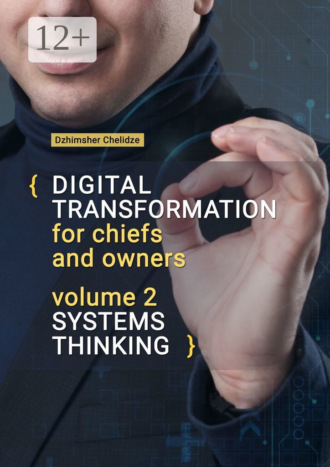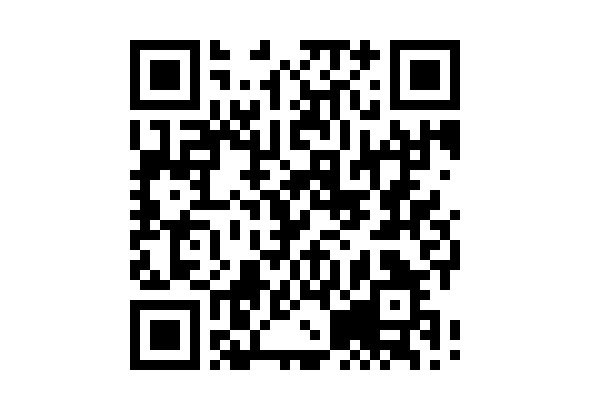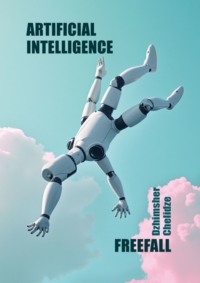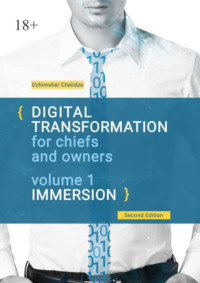
Полная версия
Digital transformation for chiefs and owners. Volume 2. Systems thinking
Where did our work on productivity lead? If at the beginning of the project we had 300—400 m2 of raw material warehouse, and the finished products were shipped from the workshop, then after all changes, we had an empty stock of raw materials, everything was started for production immediately after unloading, and the finished products were shipped from a separate warehouse with 150—200 m2. Here productivity was already limited to the supply of raw materials.
Key tools
– Method «drum – buffer – rope»
«Drum» – internal limitation, for example, limits of how much an enterprise can produce.
«Buffer» – before limitation there should be some buffer of materials stock, protecting the limit from downtime.
«Rope» – materials should be put into production only when the reserves before restriction have reached a certain minimum, not earlier, so as not to overload production (one of the principles of lean production).
– Critical chain method
Its essence is that it is necessary to reduce multitasking, get rid of the student syndrome and take into account the law of Parkinson’s.
Our brains can’t do multitasking. It’s a myth. In fact, what it does is people start switching from problem to problem, not getting any through, abandoning them, and then people have to spend their time getting into the game. This takes, on average, at least 20 minutes. Therefore, limiting the number of tasks to three, can increase human performance to 50%.
Student syndrome is the habit of many people of postponing and starting a last-minute task.
– Thought Processes
Here we use modelling and analytical schemes:
The tree of current reality is the identification of causal relationships between undesirable phenomena and the root cause of most of these phenomena.
The Conflict Resolution Diagram is the removal of contradictions and hidden conflicts in a system that often cause chronic problems.
The future reality tree is a schematic showing how the system should work with all revisions.
Transition tree – identifying and addressing possible barriers to change.
The Change Plan is an action plan with instructions for implementers.
This approach is described in artistic form in the book «Goal-2. It’s not about luck». A more formal academic language is in the book by W. Detmer «Goldratt’s Restriction Theory». You can find them by QR-code and link at the end of the chapter.
There are also eight rules in theory to follow.
– Clarity and unambiguous understanding of all terms and statements used.
– Every statement has a complete thought.
– All the causes identified cause these effects, that is, the causal link is not broken.
– The reason given is sufficient to trigger the said effect.
– Possible alternatives have been tested, and it is this reason that leads to the effect.
– Cause and effect are not confused.
– The presence of side effects in the identified cause that also point to it.
– Lack of tautology.
Constraint type
Goldratt identified the following types of restrictions:
– Physical Limitations
Limitations due to equipment performance, lack of materials, space, people.
– Political Restrictions
These and informal restrictions in the style of «we work here so» or «we have it so usual», and formal regulations and procedures. For example, the need to write letters through the first persons with approvals for 2—4 weeks of each letter instead of direct communication between the performers.
– Paradigm Constraints
These are well-established habits in work and ways of thinking, decision-making. They limit the possibilities for finding solutions and better working methods. It’s more about psychological restraints on thinking, including leaders.
Additionally, in many projects, it is the limitations in the personal effectiveness of the manager, the incompleteness of his knowledge and resources: the ability to critically approach priorities, the skills of setting objectives, concentration, attention, time, etc. eventually become a constraint on the productivity of their divisions.
– Market Restrictions
This is a situation where your capabilities and capacities are higher than market demand. This happens when you grow systematically and scale successfully and capture the entire market.
– Typical errors
Stopping the process of improvement after the next stage
You should avoid situations when after the removal of the next restriction you will say «stop, stop». Search and removal of restrictions is a continuous cycle. Restrictions will always stop. This is not a one-time project, but a permanent feature. This rule is laid down also in lean production and Kaizen philosophy (we will talk about them in the next chapter).
If you have the feeling that everything is enough, then this is the first signal of stopping development. Inertia will be fine for a while, and then degradation will begin.
– Narrow focus
Many managers focus on measurable metrics of major economic activity. And productivity is excellent, and revenue is rising, and in a good case, even profits continue to rise. As a result, they calm down, forget about building the system, work with the team and its motivation, the need to adapt to new conditions after growth. As a result, they see the problem even when all this is reflected in the figures, and begin to sound the alarm, when already half the company in chaos and extinguish the fire expensive and ineffective. You always need a system view and «helicopter vision» on work processes and product: the more areas of restrictions monitor, the better, and for this it is useful to know what are the limitations.
Chapter Summary 2
System constraint theory is an independent management tool. However, its use in digitalization projects allows you to set priorities and determine where to run and what to do first in order to obtain resources for further development. Combined with other instruments, it has a synergistic effect.
Is it necessary to use all the complex tools described above: building trees of current reality, future and so on? No. If you can look at business as a system, understand all the relationships, build a control system, it can be avoided, you will know your bottlenecks and where to direct resources as a priority. But gradually, the better your situation, the more unobvious will be the restrictions, and then you will have to dive into the work with diagrams.
At the same time, as practice shows, the main limitations are buried in the thinking of leaders. Remember the second practical example where changes were made, including changes to the operating modes of production? What do you think happened after I left and the end of crisis management? I think you’ve guessed. Managers decided that everything is fine, you can again fully include sales, without taking into account production capacity and adding «urgent orders» to the daily schedule, neglecting tactical and operational planning. In the end, three months later, everything came back: the delay started to grow, people began to complain. That is why the same Toyota warns in its thrifty production that one cannot focus on formal tools, one needs complex work, including with people. And I totally agree with that.
A detailed article with illustrations and videos is available on QR code and link below.

Theory of systems limitation
Chapter 3. Lean Production and 6 Sigma
Now let’s talk about lean manufacturing, a tool that allows you to build tactics and understand how to make the most of digital technology.
Lean production (lean manufacturing) is a management approach based on a constant commitment to excellence and loss management. Developed this Toyota approach more than 40 years ago, and it was one of the keys to its success and global leadership. In the 1990s, frugal production saved Porsche from bankruptcy, and now it lies at the heart of the production system of any global corporation.
In recent decades the essence of the concept was superimposed on «6 sigma» and it resulted «lean+6 sigma».
For a deeper dive, I recommend reading «Dao Toyota. 14 principles of management of the world’s leading company» Jeffrey Licker. All necessary links you will find in the article by QR-code.

Lean Production. Part 1
Before we get to the theory, I’ll give you three practical examples of how this tool can be used in digitalization.
Example 1
Toyota will use video cameras and neural networks to analyze employee performance and identify losses, continuously optimizing work operations.
Example 2
By standardizing the report form and automating the calculations of the required coefficients, the cost of the report in one company decreased from 3000 to 300 rubles. How? By eliminating the losses for over-processing.
Example 3
Back in the first book, I was talking about a system for evaluating knowledge. With the understanding of the principles of lean production a week after the use of the system there were recommendations to optimize its work to reduce labor costs by 70—80%! And this is an annual savings of up to 500 thousand rubles, because you no longer need a separate person who is engaged in only one system. Additionally, that’s often how big corporate IT solutions work. For example, in another case it was also necessary to hire an individual to give him a job in 1C, otherwise the production manager and the master could only do that wiring. That is why it is essential in automation, digitalization (analysis of the difference between these concepts is in the first book) and business process optimization to actively use thrifty production.
Now that you understand what this is all about, let’s go deeper and look at the key tools.
4 principles
Thrift production is based on four principles.
1. Determine the cost of a specific product to the consumer
In general, Japanese people love a value-oriented approach in both projects and work. Customer satisfaction with them almost turns into a cult. This is also reflected in the P2M project management standard.
Additionally, in part, that was one of the keys to their success, despite resource constraints after the Second World War. They simply cannot be wasteful because the price of error is too high. Now, under strict sanctions, for us their path and philosophy can become a kind of cheat sheet.
This approach is more than relevant in digital projects, including domestic ones.
It is always necessary to remember who the consumer is (intermediate, finite), in what value for him. Additionally, the most important benchmark in digital projects – what losses for people can we eliminate? We will talk about what is loss through the section.
Without it, we risk introducing changes and systems that no one wants to use, and they become just expensive toys.
2. Determine the value creation flow for this product (from raw material to finished product, from order to delivery, from concept to production)
Here you need to know the whole production chain. For this there are a number of tools. In the modelling of business processes there are the designations VAD, SIPOC. Product management includes CJM (client path map) and CX (user experience). We will also talk about these tools later.
This principle allows you to understand where you have problems, where you kill the client’s desire to cooperate, where you spend resources (time and money) in vain.
Well, what is the point of introducing robotics into production if the customer has to wait a week to confirm the order and answer 100 additional questions, while the production itself takes 1—2 days?
3. Ensure continuous flow of product value creation
This is where the work begins with the processes and the elimination of all expectations, superfluous agreements.
4. Strive for excellence
Here we talk about the fact that it is impossible to once optimize everything / automate / digitize and finish. We need to come back and improve our processes and services time and time again. People, conditions, technologies, and therefore, processes need to change.
This is at the heart of, for example, Kaizen, where people on the ground themselves eliminate all unnecessary actions, improve their working conditions.
14 DAO
14 Tao Toyota – the basic «commandments» of Toyota production system and thrifty production. It’s kind of like the 10 commandments from the Bible that allow you to realize the key principles.
DAO is divided into four sections:
– Long-term perspective philosophy;
– The right process gives the right results;
– Add value to the organization by developing your employees and partners;
– Permanent solution of fundamental problems stimulates continuous learning.
Section I. Philosophy of the long term.
Principle 1. Make management decisions from a long-term perspective, even if this is detrimental to short-term financial objectives.
It’s about focusing on long-term development, not operational performance. Additionally, unfortunately, it’s the one that’s most often ignored because it’s a psychological trap.
What do owners or shareholders usually want from top management? Right, beautiful revenue figures, operating margins, EBITDA, profitability.
As a result, all development projects, as a rule, are an attempt to sit on two chairs, to develop something, to rebuild, but not to hesitate at the moment. There’s nothing wrong with that, but, alas, it rarely works. Of course, if you move systematically and progressively, then it will be, but if you have already entered a crisis or have grown up by yourself, then this approach is unlikely to work.
Here it is important to remember the main postulate of lean production: your main task, as a person, as an employee, as a company – to create value for the consumer, society and economy. In evaluating any work, one should focus on whether it solves this problem.
Section II. The right process produces the right results.
Principle 2. A continuous flow process helps to identify problems.
Its essence is to organize the work and production process with minimal losses, stocks and unfinished production. This approach, combined with well-functioning communication, allows problems to be identified at an early stage before they become a danger or crisis. In my practice, this is generally the main rule, including in the implementation of projects – collect feedback and identify problems as early as possible.
Principle 3. Use the pull system to avoid overproduction.
Are you familiar with the situation where you are being squeezed into the work of another unit? I often see the principle when different units work on their own. As a result, there is stocking of raw materials warehouses or folders with incoming service / letters / tasks.
This is the most common problem for department heads in dealing with subordinates. Many such leaders, in fact, are «transferees» – they only throw tasks over to the executive. The employee accumulates 40—50 tasks, he tries to do everything, jumps from task to task, and in the end does nothing. Additionally, as practice shows, if you limit the number of work tasks to three, productivity rises to 50%. Firstly, a person does not jump from one task to another (the process of immersing the brain in the problem takes 20—40 minutes), secondly, he has at least some diversity and variability, this protects the psyche, and allows you not to hang on to one problem.
We need to get the domestic consumer who takes your job to get what they need at the right time and in the right amount. This is the basis of the tool «Exactly in time» – new products or tasks should come only as the previous. Additionally, here Kanban boards will help a lot. About them too, a little lower.
In general, it is necessary to minimize the unfinished production (current and for offices).
Principle 4. Distribute work evenly (heizunka): work like a turtle, not a hare.
Familiar is the situation of heroism and proverbs «sometimes empty, sometimes densely»? In Japanese philosophy it is called Mura. Additionally, one of the tasks of thrifty production is to make the load evenly, without talking at the end of the month and endless heroics. And the modern planning systems, including ERP, MES and APS, that we talked about in the first book, will help. Well, so are Kanban boards if we learn to look at the process and optimize it all the time.
Principle 5. Stop production to solve problems with part of the production culture, if so required by quality.
Why were so valued, and are Toyota cars appreciated? Right, for quality. If we want to work with clients who have money, we need to ensure quality.
Quality for the consumer determines your value proposition. Additionally, that’s where the smart machine with machine vision comes in, which is to watch the product and the process and see if everything works according to the technical process. You need a visual system that immediately notifies the leader of the problem. Therefore, in my projects, I make extensive use of color tags in task cards. For example, the green label means «Everything according to the plan», blue – coordination or waiting for information, red – «There is a problem, need help». Digital tools here in general give unlimited flexibility, the main thing – the leader daily to do a review and if problems arise, to turn on and eliminate the reasons.
If we are talking about production, the tool Dzidok (equipment with machine vision or complex automation) – the foundation for «embedding» quality.
As a result, the approach by stopping or slowing down the process and getting the required quality «from the first time» will increase the productivity of processes in the future: you will simply eliminate the causes of problems and deviations.
Principle 6. Standard objectives are the basis for continuous improvement and delegation of authority to staff.
Every time I hear the thesis «we do not have standard tasks», as a rule, it means that the team simply do not know or do not want to structure the work.
Stable and reproducible working methods – the key to process management. Additionally, his task is to create a more predictable result, improve the coherence of work, and make the output more uniform. It’s the basis of flow and pull.
Yes, if you have a very young company, then for a while it will be irrelevant, you need to run the whole system, give a result, but in the end there is nothing without it. Endless creativity always leads to crisis.
Knowledge should be captured, for example, by reviewing projects, identifying and standardizing best approaches and methods. At the same time, it is necessary to encourage the improvement of these standards. In general, continuous improvement – the main creed of thrifty production. But to improve something, it must first be described and fixed. Otherwise, there will be chaos with all the consequences. Additionally, this is also more than relevant for IT. Creative guys do not like to standardize their work, but alas, it is necessary through «I do not want».
Principle 7. Use visual control so no problem goes unnoticed.
This principle is actually part of the 5th principle. As mentioned, I use color labels. But it requires discipline, and it comes from a supervisor.
Where possible, reports should be reduced to one page, even if they were critical financial decisions. There is even an «A3 Report» tool for this.
Principle 8. Use only reliable, proven technology.
Technology should help people, not replace them. If we are talking about digitization and automation, it is often better to first do the whole process manually, and then implement the digit and automate.
First, you will see the most problematic places; secondly, avoid the illusion that everything can be automated. In addition, new technologies are often unreliable and difficult to standardize, threatening the flow. The same artificial intelligence, despite all its development, still admits sometimes quite stupid mistakes.
Therefore, instead of unverified technology, it is better to use a known, well-established process. At the same time, it is necessary to encourage the study of new technologies and ways. After all, everything worked out once was new. Additionally, it is necessary to quickly implement proven technologies that have been tested and make the flow better.
Help with this can be the selection of digital technologies and solutions taking into account TRL (ISO 16290:2013). The TRL is how mature the technology we want to introduce is. Therefore, the technology has 9 levels of readiness:
TRL 1: The basic principles of technology have been studied and published;
TRL 2: The concept of technology and its application is formulated;
TRL 3: Critical functions or characteristics are validated analytically and experimentally;
TRL 4: Component or layout tested under laboratory conditions;
TRL 5: Component or layout tested in conditions close to real;
TRL 6: System/subsystem or prototype model demonstrated in near real conditions;
TRL 7: Prototype system demonstrated in operation;
TRL 8: The real system is completed and qualified during tests and demonstration;
TRL 9: The real system is confirmed by a successful operation (goal achievement).
Accordingly, the more critical the impact of new technology, including digital technology, on the final product, and the higher the reliability requirements of the product, the higher the maturity level should be.
Section III. Add value to the organization by developing your employees and partners.
Principle 9. Educate leaders who know their business thoroughly, profess the company philosophy and can teach others this.
It is better to educate your leaders than to buy them outside the company. First, it is one of the key rules of motivation. When you constantly hire outsiders, you discourage your people. They begin to lose faith in the future. As a result, they focus on their goals and do not have to expect their full contribution. Second, leaders who know their business by default have high expert power and know all the pitfalls of your activities. Additionally, digitalization and automation are all about that.
Train staff in the basics of lean manufacturing, design management, digitalization, and collect feedback from the beginning.
In addition, a leader should not only perform his tasks and have the skills of communicating with people, he should also profess the philosophy of the company and set a personal example of attitude to the case.
Principle 10. Educate exceptional people and form teams that profess the company philosophy.
Principle 11. Respect your partners and suppliers, make them difficult and help them improve.
You can be as digital as you want, but if your partners live in paper, the effect will be limited. Here, as in systems constraint theory, chain strength is determined by the weakest link.
It is necessary to create conditions for partners to grow and help them to demonstrate their high efficiency.
Section IV. Permanent solution of fundamental problems stimulates continuous learning.
Principle 12. To understand the situation, you need to see everything with your own eyes (genti genbutsu).
How often have I seen stories where TOPs trusted their managers and reports on the computer? Here is a practical example. The founder of the company was from the production. Weekly he went to the production. And in the end, people understood that their work was important, motivated, and he had reliable information.






